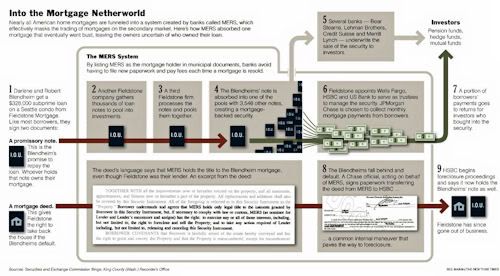The Wall Street “invention” that let them off-load the Risk of thousands of bundled Mortgages, to unsuspecting investors like Pension Funds and Municipalities, under the fraudulent stamp of AAA Securities, in exchange for “trough-like” income streams — They’re Back!
CDO-type risk-shifting contracts are being pedaled to the greedy and unsuspecting, as a sure-fire way to beat the Treasuries market. And people high-roller investors are buying them.
Because they are new and improved with a shiny new Name (BTO), customized just for the individual “investor’s” desired outcomes. Surprise!
…..
by Lisa Abramowicz, bloomberg.com -- Feb 4, 2015
[...]
Goldman Sachs Group Inc. is joining other banks in peddling something they’re referring to as a “bespoke tranche opportunity.” [BTO] That’s essentially a CDO backed by single-name credit-default swaps, customized based on investors’ wishes. The pools of derivatives are cut into varying slices of risk that are sold to investors such as hedge funds.
…..
The derivatives are similar to a product that became popular during the last credit boom and exacerbated losses when markets seized up. [...]
“A tranche of a bespoke portfolio of credits can offer exposure to diversified risk with the possibility of leverage, credit enhancement and enhanced returns,” according to a Jan. 23 e-mail message from a Goldman Sachs employee, reviewed by Bloomberg News. It went out with the header: “Goldman: BESPOKE TRANCHE OPPORTUNITY.”
And the best/worst part about this new BTO investment for “off-loading” Bankers’ everyday Risks — they aren’t subject to the ‘watered-down’ regulations of Dodd-Frank, that target the CDO’s that caused the last Wall Street disaster ...
by Alan Pyke, thinkprogress.org -- Feb 5, 2015
[...]
Like other derivatives, these [Bespoke Tranche Opportunities] “BTOs” allow investors to place wagers on the outcome of various loans, bonds, and securities in which they are not directly invested. Hedge funds and other sophisticated financial industry actors use derivatives both as a form of insurance to manage the total risk they are exposed to across their whole investment portfolio, and to gamble on real-world economic events such as mortgage payments, municipal bonds, and the price of physical commodities. The resulting web of complicated contracts can be very difficult to untangle, and can involve impossible-sounding amounts of money. The Financial Crisis Inquiry Commission concluded that derivatives “were at the center of the storm” and “amplified the losses from the collapse of the housing bubble by allowing multiple bets on the same securities.” In 2010, the total on-paper value of every derivative contract worldwide was $1.4 quadrillion, or 23 times the total economic output of the entire planet.
…..
Collateralized debt obligations (CDOs) are a form of derivative that breaks one pool of financial assets — either direct loans or securities that are based on groups of loans — into multiple layers of riskiness. Those layers care called tranches, and investors who buy the least-risky tranche of the derivative will get paid before those who buy the second tranche, and so on. Banks selling traditional CDOs had to create these multiple risk tranches based on a given set of loans or securities, and then hope that someone would buy each of them.
The new “bespoke” version of the idea flips that business dynamic around. An investor tells a bank what specific mixture of derivatives bets it wants to make, and the bank builds a customized product with just one tranche that meets the investor’s needs. Like a bespoke suit, the products are tailored to fit precisely, and only one copy is ever produced. The new products are a symptom of the larger phenomenon of banks taking complex risks in pursuit of higher investment returns, Americans for Financial Reform’s Marcus Stanley said in an email, and BTOs “could be automatically exempt” from some Dodd-Frank rules. [...]
Investments in BTO’s jumped to 20 Billion last year, from a total of only 5B the year prior. Wall Streets may have found their new loophole, for escaping the consequences of their own shoddy investment decisions. Heads They Win — Tails Somebody else always Loses!
Here is an image that shows how the trickle down nonsense of old CDO’s theoretically worked, from the Wikipedia page on Collateralized debt obligation:
 A tranche by any other name, is a siphon on other people’s sweat and tears.
A tranche by any other name, is a siphon on other people’s sweat and tears.
larger
Only problem was, this pyramid scheme only “worked” when housing prices were rising, and mortgage-holders kept making those thousands of mortgage payments. The Market meltdown of 2007-08 showed us what happens when 1.4 Quadrillions in Market bets, all go south at the same time. In brief, it wasn’t pretty. Real People, Real Investments, Real Homes — get deconstructed in one fell swoop.
 Mortgage Electronic Registration Systems (MERS) — the Mix-master of Mortgage paper trails.
Mortgage Electronic Registration Systems (MERS) — the Mix-master of Mortgage paper trails.
larger
Our Home Mortgages were never meant to become the fodder of so many Billionaire roulette wheels.
Yet here we are. Deja vu all over again. Such is the inventiveness of Wall Street — always scheming to find another sneaky way to make a windfall, using Other People’s Money.
What’s to stop them?
…..
=======================
=======================
Here’s some more on the nitty-gritty on the how those CDO derivatives Contracts worked (to collapse the economy), in Wall Street’s last scam. Hopefully, we won’t wait until after-the-fact to find out the nuts-and-bolts of their latest get rich invention … Currently flying underneath the radar, near you.
…..
by Jon Ogg, investopedia.com -- July 24, 2007
How do CDOs work?
Initially, all the cash flows from a CDO's collection of assets are pooled together. This pool of payments is separated into rated tranches. Each tranche also has a perceived (or stated) debt rating to it. The highest end of the credit spectrum is usually the 'AAA' rated senior tranche. The middle tranches are generally referred to as mezzanine tranches and generally carry 'AA' to 'BB' ratings and the lowest junk or unrated tranches are called the equity tranches. Each specific rating determines how much principal and interest each tranche receives. (Keep reading about tranches in Profit From Mortgage Debt With MBS and What is a tranche?)
The 'AAA'-rated senior tranche is generally the first to absorb cash flows and the last to absorb mortgage defaults or missed payments. As such, it has the most predictable cash flow and is usually deemed to carry the lowest risk. On the other hand, the lowest rated tranches usually only receive principal and interest payments after all other tranches are paid. Furthermore they are also first in line to absorb defaults and late payments. Depending on how spread out the entire CDO structure is and depending on what the loan composition is, the equity tranche can generally become the "toxic waste" portion of the issue.
[...]
Who Buys CDOs?
Generally speaking, it is rare for John Q. Public to directly own a CDO. Insurance companies, banks, pension funds, investment managers, investment banks and hedge funds are the typical buyers. These institutions look to outperform Treasury yields, and will take what they hope is appropriate risk to outperform Treasury returns. Added risk yields higher returns when the payment environment is normal and when the economy is normal or strong. When things slow or when defaults rise, the flip side is obvious and greater losses occur.
 It’s OUR American Dream, or at least it used to be ...
It’s OUR American Dream, or at least it used to be ...
Let’s make it so, again.


